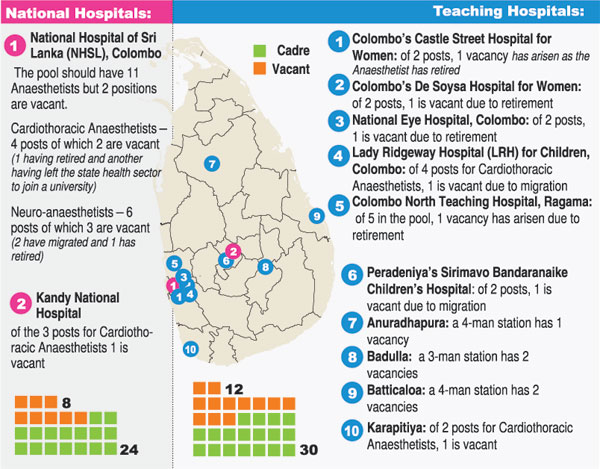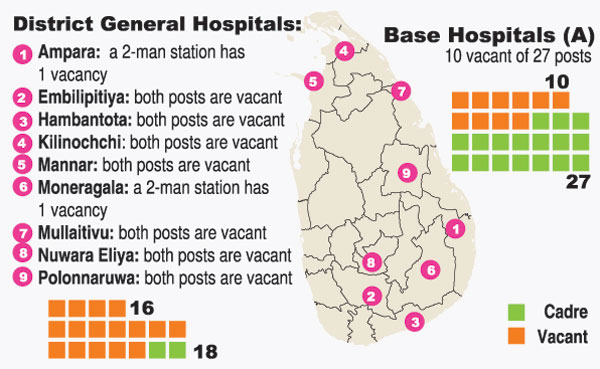News
Chilling data – dearth of over 40 Anaesthetists in state hospitals
View(s):By Kumudini Hettiarachchi
Consultant Anaesthetists who scrupulously monitor the vital signs of patients during surgical operations or other procedures are hard to come by in state sector hospitals in the country.
The dearth of Consultant Anaesthetists brings about a domino effect, one event causing a series of related events, many told the Sunday Times, describing how it impacts not only on operations performed by Consultant General Surgeons but also Caesarian-sections and gynaecological surgeries conducted by Consultant Obstetricians & Gynaecologists as well as other procedures such as endoscopies and colonoscopies.
There are 33 vacancies for Consultant Anaesthetists in the 2023 Annual Transfer List, a medical specialist pointed out, but another 15 vacancies have also been identified. These comprise Anaesthetists who have already retired; migrated or resigned from the health service and joined universities, whose names are still on the list.

Another cautioned that if the ‘retirement at 60 plan’ is implemented, the state health system would lose another 12 Anaesthetists as at December 31, 2024.
When taking stock of the ground situation right now, the chilling revelation is that there would be anything between 45 and 50 vacancies for Anaesthetists.
Analysing the 2023 Transfer List, one pointed out that it assumes that 20 newly board-certified (Post-graduate Institute of Medicine) Consultant Anaesthetists would be joining this list.
“However, of these 20 Anaesthetists, 9 are missing as they have migrated and 2 have left the state health sector and joined the medical faculties of universities under the higher education sector. Of the 9 left to join the Transfer List, 7 have applied for hospital appointments but 2 who are eligible have simply not done so. So the number 20 in reality is not true,” the specialist said.
Another looked at the state sector hospital categories: National Hospitals – 2; Teaching Hospitals – 20; Provincial General Hospitals – 2; District General Hospitals – 20; and Base Hospitals (A) – 27 & Base Hospitals (B) – 44.
Pointing out that all Base Hospitals dubbed ‘A’ usually have Anaesthetists, this specialist said that even a few Base Hospitals dubbed ‘B’ also had this specialty.
See the spine-tingling data on vacancies for Consultant Anaesthetists in the possession of the Sunday Times in the graphic.
Specialists were deeply divided over the brain drain. Some were critical of the mismanaged economic situation which has led to high taxes being imposed in addition to the sky-rocketing cost of living, lack of travel allowances and poor housing, warning that the collapse of the state health sector was imminent.

They stressed that while officials showed on paper that everything was fine by portraying a picture of the main hospitals in the cities having the required specialists, the peripheral hospitals were collapsing.
This would ultimately overload the main hospitals, they warned, adding that all those serving in Base Hospitals would apply and move to bigger hospitals as vacancies occur in them, thus disabling work at Base Hospitals.
However, others blamed mal-distribution of specialists as a major problem. When specialists with training in niche specialties return to Sri Lanka from abroad, they are sometimes posted to hospitals where they cannot utilise their skills as there are no facilities. The whole system needs to be re-visited, one said.
| How to overcome the crisis The million dollar question is how to overcome the current shortage of all specialists including Consultant Anaesthetists. Many specialists themselves had several solutions to the problem:
A doable cluster system was also suggested. This would entail each Base Hospital being put under the wing of the area’s District General Hospital. Then specialists could visit the Base Hospital about two days a week to conduct a clinic and do up an operation list. On other days, patients could be transferred to the District General Hospital. Some examples how the cluster could work: The Ampara District General Hospital to be clustered with the Maha Oya Base Hospital; Hambantota with Tissamaharama; Moneragala with Bibile; Nawalapitiya with Dick Oya; Nuwara Eliya with Welimada; Polonnaruwa with Medirigiriya; and Trincomalee with Kinniya. As no consultant would be willing to take on added responsibility for free and without an incentive, one specialist said, those part of the cluster system should be provided transportation costs in addition to an extra allowance of at least Rs. 100,000. | |
The best way to say that you found the home of your dreams is by finding it on Hitad.lk. We have listings for apartments for sale or rent in Sri Lanka, no matter what locale you're looking for! Whether you live in Colombo, Galle, Kandy, Matara, Jaffna and more - we've got them all!

